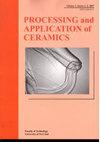基于立体光刻增材制造的光敏氧化铝浆料粘度优化
IF 0.8
4区 材料科学
Q3 MATERIALS SCIENCE, CERAMICS
引用次数: 0
摘要
氧化铝浆料的粘度是影响立体光刻成型陶瓷质量的关键因素,但它与树脂分布比、分散剂含量、增塑剂含量和固体含量密切相关。研究人员大多采用单因素法来研究料浆的组成和配比。本研究采用正交试验设计和反向传播人工神经网络相结合的方法,解决了多目标、多因素影响氧化铝浆料性能的优化问题。通过反向传播人工神经网络和实验测试,获得了最优的成分和内容分配结果。结果表明,最佳工艺条件为:树脂组成HDDA: PPTTA = 4:1, DS-165A分散剂含量为3.86wt。%, PEG增塑剂用量3.5wt。固含量为75.74wt.%。预测最佳粘度值为8787mPa?S,收缩率可达14.57%。黏度和收缩率的最优值与实验结果一致,黏度和收缩率误差分别仅为4.06%和3.856%。烧结试样的平均密度和抗弯强度为3.979 ?0.005 g/cm3和365 ?分别为61 mpa。根据获得的数据,成功制备了流动性好、收缩率低的立体光刻3D打印氧化铝浆料。本文章由计算机程序翻译,如有差异,请以英文原文为准。
Viscosity optimisation of photosensitive al2o3 slurry for stereolithography based additive manufacturing
Viscosity of alumina slurry is a key factor affecting the quality of ceramics formed by stereo photolithography, but it is closely related to the resin distribution ratio, dispersant content, plasticizer content and solid content. Most researchers utilize the single factor method to study the composition and ratio of the slurry. In this study, orthogonal experimental design and back propagation artificial neural networks methods were combined to solve the optimisation problem of multi-objective and multi-factor influence on alumina slurry performances. The results of optimal composition and content allocation were achieved by back propagation artificial neural networks and experimental testing. It was shown that the optimal conditions are: resin composition HDDA : PPTTA = 4 : 1, DS-165A dispersant content of 3.86wt.%, PEG plasticiser amount of 3.5wt.% and the solid content of 75.74wt.%. The predicted optimal viscosity value was 8787mPa?s and the shrinkage rate could reach 14.57%. The optimal values of viscosity and shrinkage were consistent with the experimental results, the viscosity and shrinkage errors were only 4.06% and 3.856%, respectively. The average density and bending strength of the sintered samples were 3.979 ? 0.005 g/cm3 and 365 ? 61MPa, respectively. According to the obtained data, stereolithography 3D printing alumina slurry with excellent flowability and low shrinkage was successfully prepared.
求助全文
通过发布文献求助,成功后即可免费获取论文全文。
去求助
来源期刊

Processing and Application of Ceramics
MATERIALS SCIENCE, CERAMICS-
CiteScore
1.90
自引率
9.10%
发文量
14
审稿时长
10 weeks
期刊介绍:
Information not localized
 求助内容:
求助内容: 应助结果提醒方式:
应助结果提醒方式:


